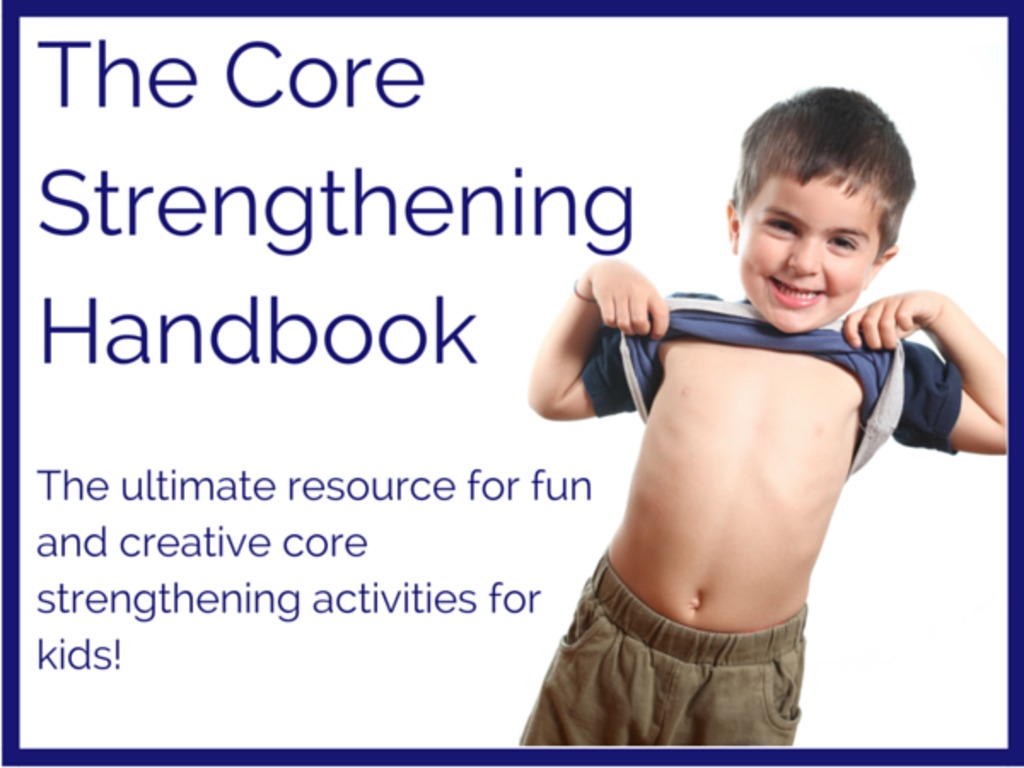Important Core Strength Handbook for Greater Learning Development

This article discusses how your child’s learning relates to core strength and contains affiliate links for your convenience.
Over the years, diet and exercise have become a huge part of our every day lives. The more we hear about diabetes, obesity and other health-related challenges, our natural instinct is to become more active and eat healthier foods to help our bodies. Many times we even want to look like the famous movie stars on TV and that’s why we spend countless hours at the gym training for marathons, lifting weights and eating more protein and veggies. We are constantly trying to build, strengthen and sculpt our bodies to be stronger, healthier people.
However, sometimes we fail to remember how important it is to help our children build and strengthen their muscles as well. Research has shown there is a correlation with a child’s core muscle strength and how they learn in the classroom. Something as simple as poor posture, a weak back and stomach, fragile arms, and frail hands and fingers can all relate back to how your child memorizes facts and retains information, speaks and expresses themselves. If a child doesn’t have enough strengthen to lift their head to copy notes off the chalkboard at school, how can they learn? Now many of you may think “what child doesn’t have the strength to look at the chalkboard,” but you’d be surprised at how many students I see on a daily basis who slouch in their chair, lay on my table and don’t even have enough muscle tone to bend over or balance on one foot. That is why we continue our dedicated efforts to creating more awareness with parents, teachers and clinicians about helping children improve the neural connections in their brains with special movement exercises.
As I continue to do my own research, I have found a number of resources and exercises that bring fresh ideas to our center to challenge our students both at home and at school. The important thing to remember is children struggling with learning challenges spend more time at school and at home than with us. I typically only see students for maybe one to two hours a week depending on the age of the child, which leaves several more hours in the week for children to go back to old habits. That is why it is a team effort with parents and teachers when they aren’t at our center to fill those gaps when I’m not around.
Core Strengthening Handbook
I have many parents who ask me if we have a special handbook or resource guide they can use to do some of the same exercises at home that we do in our center since children usually need to do these exercises every day for 20 minutes. One of the newest e-books I found that has some of the best exercises and explains just how important core muscle is when learning in the classroom, is the “Core Strengthening Handbook” written by a well-known Occupational Therapist, Claire Heffron, and Physical Therapist, Lauren Drobnjak, who are both bloggers at The Inspired Treehouse. This handbook has more than 50 activities, exercises and games all dedicated to helping your child build their gross and fine motor skills. Most of the activities we do at our center on a daily basis. It even includes activities you can do with our without toys and objects (for example, scooters, exercise balls and bolsters).
How to recognize signs of poor core strength
What I also love about the Core Strengthening Handbook is that it talks about the signs and symptoms you may see in your child if they don’t have the core muscle strength they need for learning. Some of the signs include the following:
- Poor posture (also a sign of retained primitive reflexes, which could cause developmental delays)
- Slumping
- Fidgeting
- Poor balance and coordination
- Hands and fingers have trouble with writing letters and numbers
- W-sitting
- Has difficulty putting on shoes and socks because they aren’t strong enough to hold up the trunk of their body
Core strength exercises and activities
The Core Strengthening Handbook also includes important exercises like the superhero activity for improving prone and supine extensions in your child’s back and stomach. If you remember our Superman article, it talks about how important these exercises are for helping your child develop their vestibular and sensory systems. According to Dr. A Jean Ayers, PhD, “Prone (lying on the tummy) is the position in which normal infants develop many of the postural and motor responses that lead to standing, walking and other adult sensory-motor activities.”
In addition, other activities like the crab walk are included in our handy handbook to help your child develop the core muscles in your child’s legs, arms and torso.
You can easily save this e-book to your computer or print it to take with you on vacations, to family parties and when running long errands. If you have movers or sensory seekers, these can be especially helpful to carry with you so you can use some of these exercises when your child needs help regulating their emotions, meltdowns or anxiety attacks.
What’s great about the Core Strengthening Handbook is that it is only $12.99. Click here to get your copy now so you don’t miss out on this great offer.
Many of our parents and students have already benefited from these exercises and are seeing improvements in their child’s behavior, attention, hand-eye coordination, and gross and fine motor skills in the classroom.

Πρόσφατα Άρθρα
Splish, Splash, the Benefits of Water Play for Children
Independent Play can Boost Confidence, Creativity, and So Much More



